Change Management Report
VerifiedAdded on 2020/03/04
|9
|1599
|250
Report
AI Summary
This report delves into the concept of change management within organizations, discussing various types of changes such as organizational, transformational, and personnel changes. It highlights the importance of leadership support, resource allocation, and effective communication in successfully implementing change. The report also examines common pitfalls that can lead to failure in change initiatives, using real-world examples to illustrate these challenges. Overall, it serves as a comprehensive guide for understanding the dynamics of change management in a corporate setting.
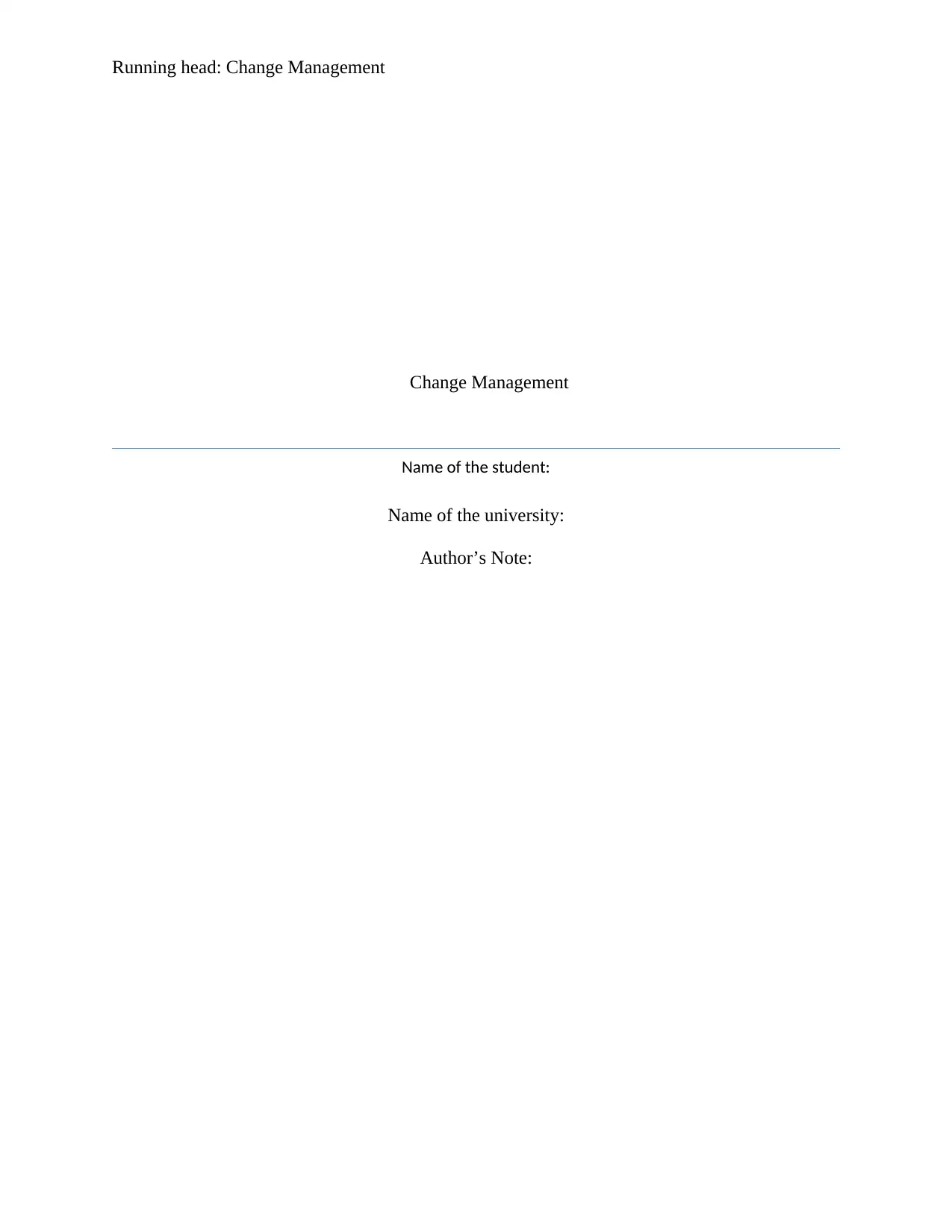
Running head: Change Management
Change Management
Name of the student:
Name of the university:
Author’s Note:
Change Management
Name of the student:
Name of the university:
Author’s Note:
Paraphrase This Document
Need a fresh take? Get an instant paraphrase of this document with our AI Paraphraser
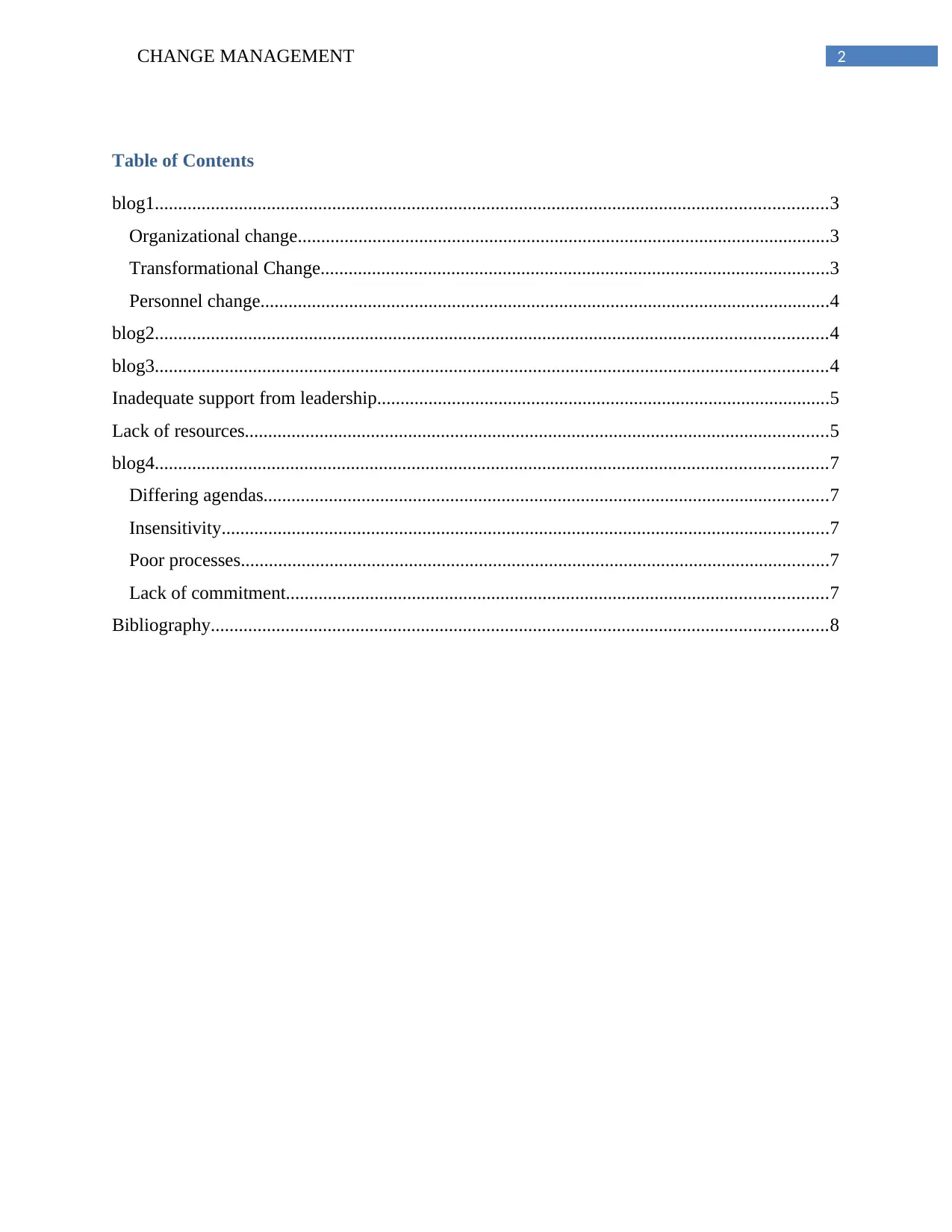
2CHANGE MANAGEMENT
Table of Contents
blog1................................................................................................................................................3
Organizational change..................................................................................................................3
Transformational Change.............................................................................................................3
Personnel change..........................................................................................................................4
blog2................................................................................................................................................4
blog3................................................................................................................................................4
Inadequate support from leadership.................................................................................................5
Lack of resources.............................................................................................................................5
blog4................................................................................................................................................7
Differing agendas.........................................................................................................................7
Insensitivity..................................................................................................................................7
Poor processes..............................................................................................................................7
Lack of commitment....................................................................................................................7
Bibliography....................................................................................................................................8
Table of Contents
blog1................................................................................................................................................3
Organizational change..................................................................................................................3
Transformational Change.............................................................................................................3
Personnel change..........................................................................................................................4
blog2................................................................................................................................................4
blog3................................................................................................................................................4
Inadequate support from leadership.................................................................................................5
Lack of resources.............................................................................................................................5
blog4................................................................................................................................................7
Differing agendas.........................................................................................................................7
Insensitivity..................................................................................................................................7
Poor processes..............................................................................................................................7
Lack of commitment....................................................................................................................7
Bibliography....................................................................................................................................8
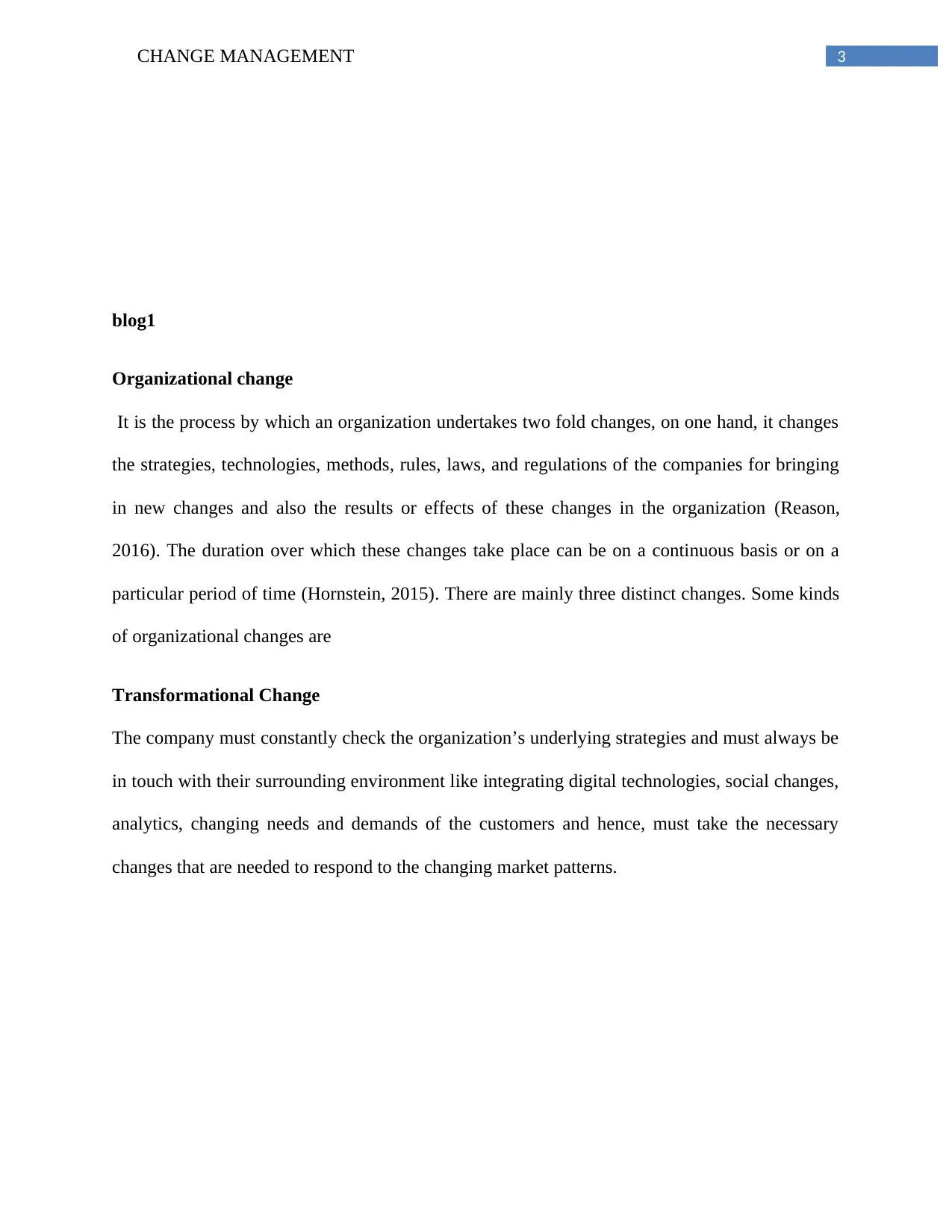
3CHANGE MANAGEMENT
blog1
Organizational change
It is the process by which an organization undertakes two fold changes, on one hand, it changes
the strategies, technologies, methods, rules, laws, and regulations of the companies for bringing
in new changes and also the results or effects of these changes in the organization (Reason,
2016). The duration over which these changes take place can be on a continuous basis or on a
particular period of time (Hornstein, 2015). There are mainly three distinct changes. Some kinds
of organizational changes are
Transformational Change
The company must constantly check the organization’s underlying strategies and must always be
in touch with their surrounding environment like integrating digital technologies, social changes,
analytics, changing needs and demands of the customers and hence, must take the necessary
changes that are needed to respond to the changing market patterns.
blog1
Organizational change
It is the process by which an organization undertakes two fold changes, on one hand, it changes
the strategies, technologies, methods, rules, laws, and regulations of the companies for bringing
in new changes and also the results or effects of these changes in the organization (Reason,
2016). The duration over which these changes take place can be on a continuous basis or on a
particular period of time (Hornstein, 2015). There are mainly three distinct changes. Some kinds
of organizational changes are
Transformational Change
The company must constantly check the organization’s underlying strategies and must always be
in touch with their surrounding environment like integrating digital technologies, social changes,
analytics, changing needs and demands of the customers and hence, must take the necessary
changes that are needed to respond to the changing market patterns.
⊘ This is a preview!⊘
Do you want full access?
Subscribe today to unlock all pages.

Trusted by 1+ million students worldwide
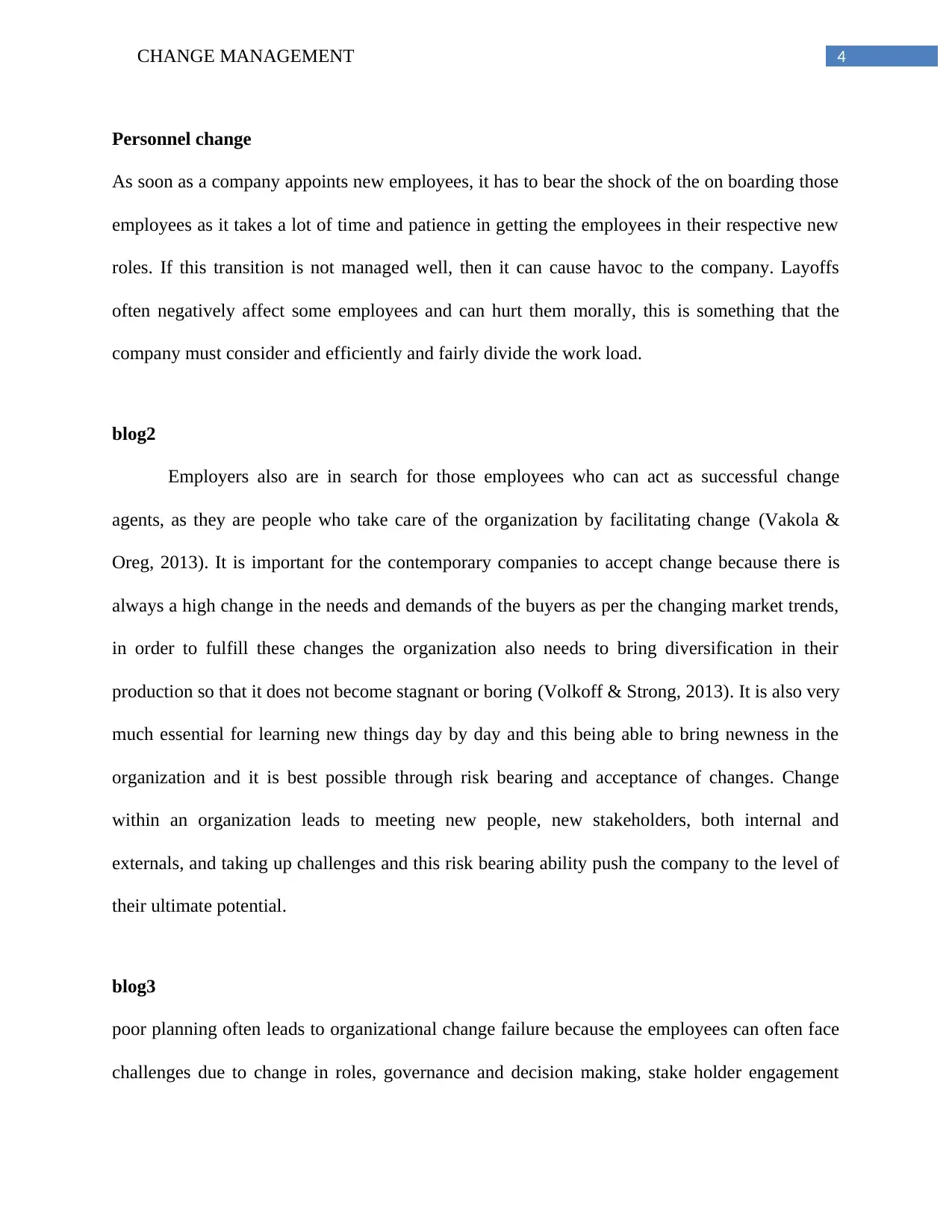
4CHANGE MANAGEMENT
Personnel change
As soon as a company appoints new employees, it has to bear the shock of the on boarding those
employees as it takes a lot of time and patience in getting the employees in their respective new
roles. If this transition is not managed well, then it can cause havoc to the company. Layoffs
often negatively affect some employees and can hurt them morally, this is something that the
company must consider and efficiently and fairly divide the work load.
blog2
Employers also are in search for those employees who can act as successful change
agents, as they are people who take care of the organization by facilitating change (Vakola &
Oreg, 2013). It is important for the contemporary companies to accept change because there is
always a high change in the needs and demands of the buyers as per the changing market trends,
in order to fulfill these changes the organization also needs to bring diversification in their
production so that it does not become stagnant or boring (Volkoff & Strong, 2013). It is also very
much essential for learning new things day by day and this being able to bring newness in the
organization and it is best possible through risk bearing and acceptance of changes. Change
within an organization leads to meeting new people, new stakeholders, both internal and
externals, and taking up challenges and this risk bearing ability push the company to the level of
their ultimate potential.
blog3
poor planning often leads to organizational change failure because the employees can often face
challenges due to change in roles, governance and decision making, stake holder engagement
Personnel change
As soon as a company appoints new employees, it has to bear the shock of the on boarding those
employees as it takes a lot of time and patience in getting the employees in their respective new
roles. If this transition is not managed well, then it can cause havoc to the company. Layoffs
often negatively affect some employees and can hurt them morally, this is something that the
company must consider and efficiently and fairly divide the work load.
blog2
Employers also are in search for those employees who can act as successful change
agents, as they are people who take care of the organization by facilitating change (Vakola &
Oreg, 2013). It is important for the contemporary companies to accept change because there is
always a high change in the needs and demands of the buyers as per the changing market trends,
in order to fulfill these changes the organization also needs to bring diversification in their
production so that it does not become stagnant or boring (Volkoff & Strong, 2013). It is also very
much essential for learning new things day by day and this being able to bring newness in the
organization and it is best possible through risk bearing and acceptance of changes. Change
within an organization leads to meeting new people, new stakeholders, both internal and
externals, and taking up challenges and this risk bearing ability push the company to the level of
their ultimate potential.
blog3
poor planning often leads to organizational change failure because the employees can often face
challenges due to change in roles, governance and decision making, stake holder engagement
Paraphrase This Document
Need a fresh take? Get an instant paraphrase of this document with our AI Paraphraser
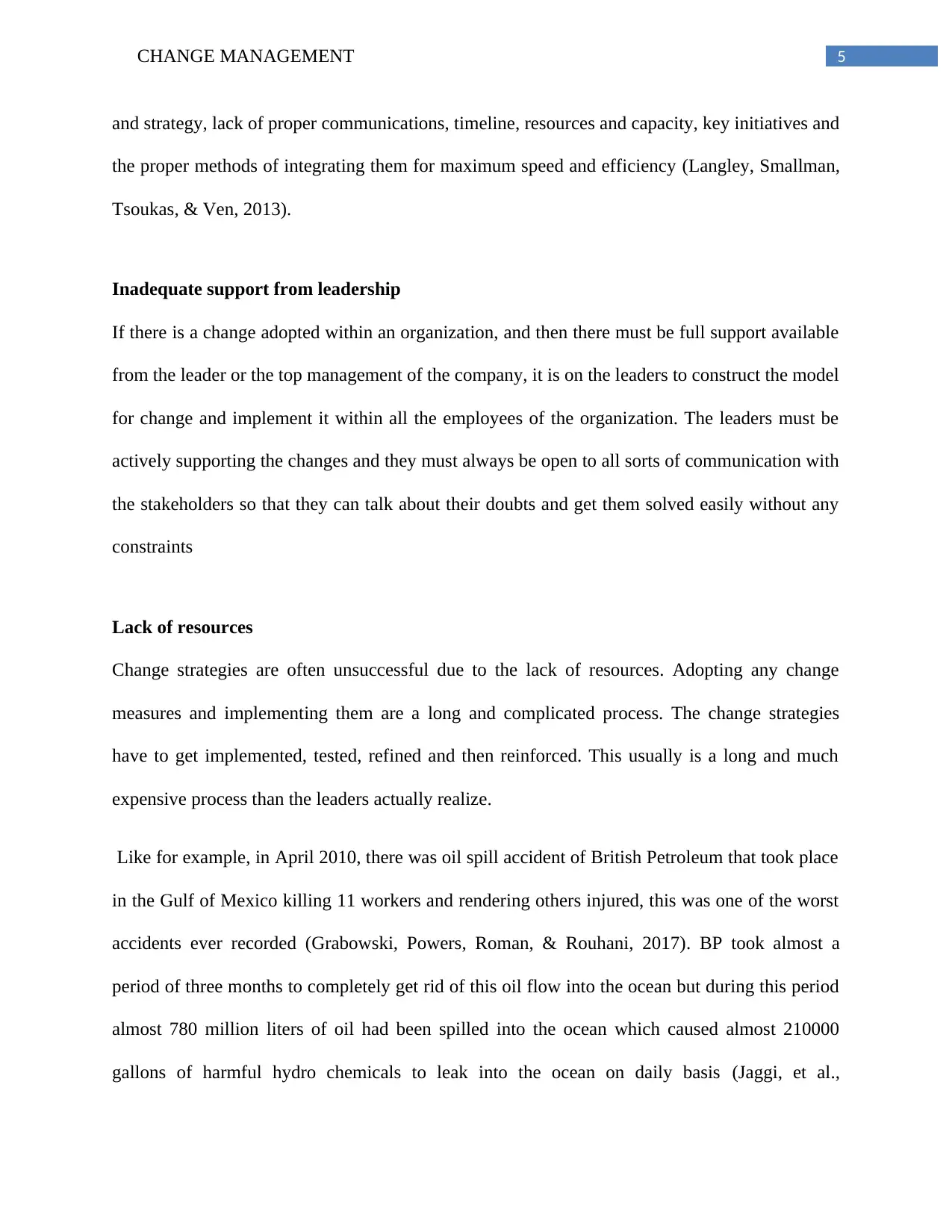
5CHANGE MANAGEMENT
and strategy, lack of proper communications, timeline, resources and capacity, key initiatives and
the proper methods of integrating them for maximum speed and efficiency (Langley, Smallman,
Tsoukas, & Ven, 2013).
Inadequate support from leadership
If there is a change adopted within an organization, and then there must be full support available
from the leader or the top management of the company, it is on the leaders to construct the model
for change and implement it within all the employees of the organization. The leaders must be
actively supporting the changes and they must always be open to all sorts of communication with
the stakeholders so that they can talk about their doubts and get them solved easily without any
constraints
Lack of resources
Change strategies are often unsuccessful due to the lack of resources. Adopting any change
measures and implementing them are a long and complicated process. The change strategies
have to get implemented, tested, refined and then reinforced. This usually is a long and much
expensive process than the leaders actually realize.
Like for example, in April 2010, there was oil spill accident of British Petroleum that took place
in the Gulf of Mexico killing 11 workers and rendering others injured, this was one of the worst
accidents ever recorded (Grabowski, Powers, Roman, & Rouhani, 2017). BP took almost a
period of three months to completely get rid of this oil flow into the ocean but during this period
almost 780 million liters of oil had been spilled into the ocean which caused almost 210000
gallons of harmful hydro chemicals to leak into the ocean on daily basis (Jaggi, et al.,
and strategy, lack of proper communications, timeline, resources and capacity, key initiatives and
the proper methods of integrating them for maximum speed and efficiency (Langley, Smallman,
Tsoukas, & Ven, 2013).
Inadequate support from leadership
If there is a change adopted within an organization, and then there must be full support available
from the leader or the top management of the company, it is on the leaders to construct the model
for change and implement it within all the employees of the organization. The leaders must be
actively supporting the changes and they must always be open to all sorts of communication with
the stakeholders so that they can talk about their doubts and get them solved easily without any
constraints
Lack of resources
Change strategies are often unsuccessful due to the lack of resources. Adopting any change
measures and implementing them are a long and complicated process. The change strategies
have to get implemented, tested, refined and then reinforced. This usually is a long and much
expensive process than the leaders actually realize.
Like for example, in April 2010, there was oil spill accident of British Petroleum that took place
in the Gulf of Mexico killing 11 workers and rendering others injured, this was one of the worst
accidents ever recorded (Grabowski, Powers, Roman, & Rouhani, 2017). BP took almost a
period of three months to completely get rid of this oil flow into the ocean but during this period
almost 780 million liters of oil had been spilled into the ocean which caused almost 210000
gallons of harmful hydro chemicals to leak into the ocean on daily basis (Jaggi, et al.,
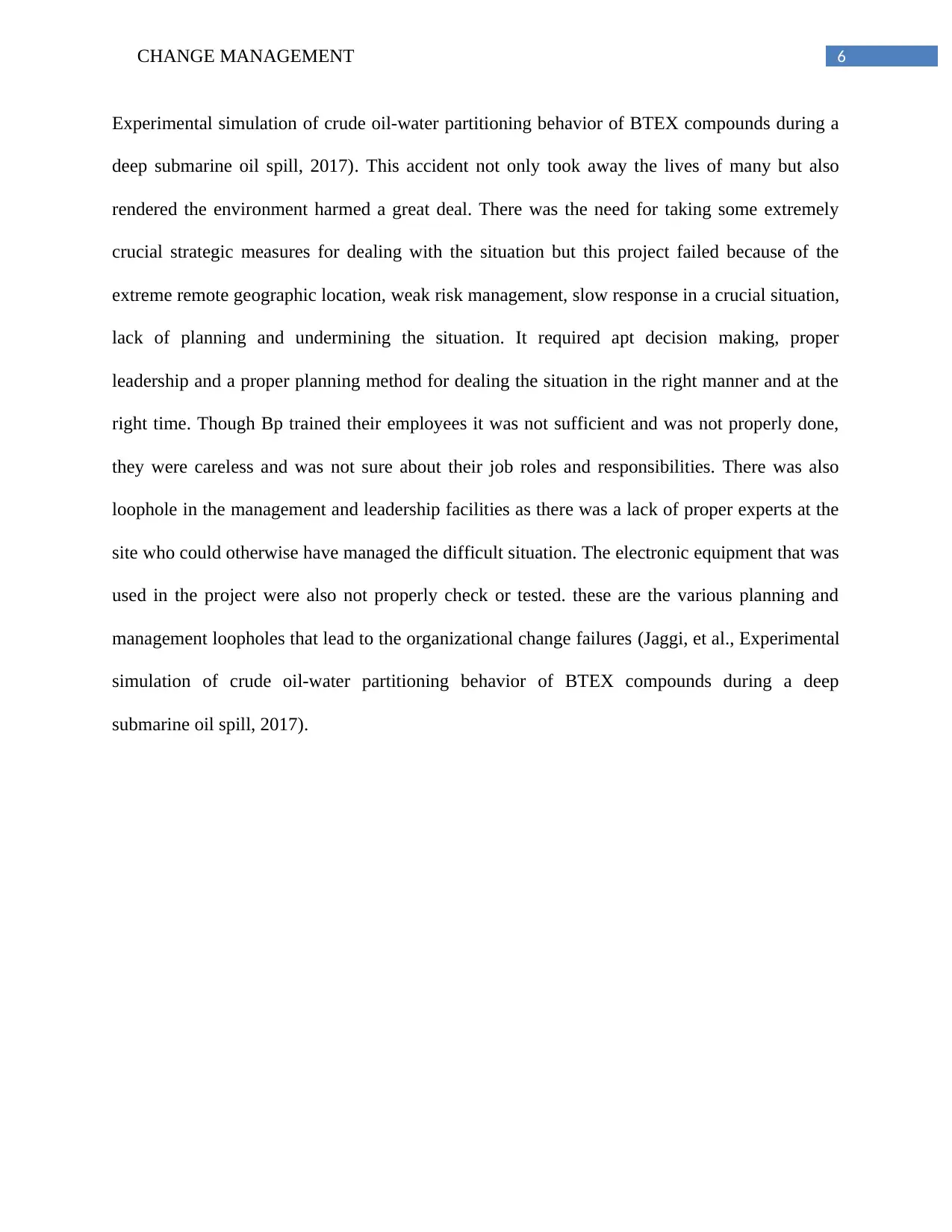
6CHANGE MANAGEMENT
Experimental simulation of crude oil-water partitioning behavior of BTEX compounds during a
deep submarine oil spill, 2017). This accident not only took away the lives of many but also
rendered the environment harmed a great deal. There was the need for taking some extremely
crucial strategic measures for dealing with the situation but this project failed because of the
extreme remote geographic location, weak risk management, slow response in a crucial situation,
lack of planning and undermining the situation. It required apt decision making, proper
leadership and a proper planning method for dealing the situation in the right manner and at the
right time. Though Bp trained their employees it was not sufficient and was not properly done,
they were careless and was not sure about their job roles and responsibilities. There was also
loophole in the management and leadership facilities as there was a lack of proper experts at the
site who could otherwise have managed the difficult situation. The electronic equipment that was
used in the project were also not properly check or tested. these are the various planning and
management loopholes that lead to the organizational change failures (Jaggi, et al., Experimental
simulation of crude oil-water partitioning behavior of BTEX compounds during a deep
submarine oil spill, 2017).
Experimental simulation of crude oil-water partitioning behavior of BTEX compounds during a
deep submarine oil spill, 2017). This accident not only took away the lives of many but also
rendered the environment harmed a great deal. There was the need for taking some extremely
crucial strategic measures for dealing with the situation but this project failed because of the
extreme remote geographic location, weak risk management, slow response in a crucial situation,
lack of planning and undermining the situation. It required apt decision making, proper
leadership and a proper planning method for dealing the situation in the right manner and at the
right time. Though Bp trained their employees it was not sufficient and was not properly done,
they were careless and was not sure about their job roles and responsibilities. There was also
loophole in the management and leadership facilities as there was a lack of proper experts at the
site who could otherwise have managed the difficult situation. The electronic equipment that was
used in the project were also not properly check or tested. these are the various planning and
management loopholes that lead to the organizational change failures (Jaggi, et al., Experimental
simulation of crude oil-water partitioning behavior of BTEX compounds during a deep
submarine oil spill, 2017).
⊘ This is a preview!⊘
Do you want full access?
Subscribe today to unlock all pages.

Trusted by 1+ million students worldwide
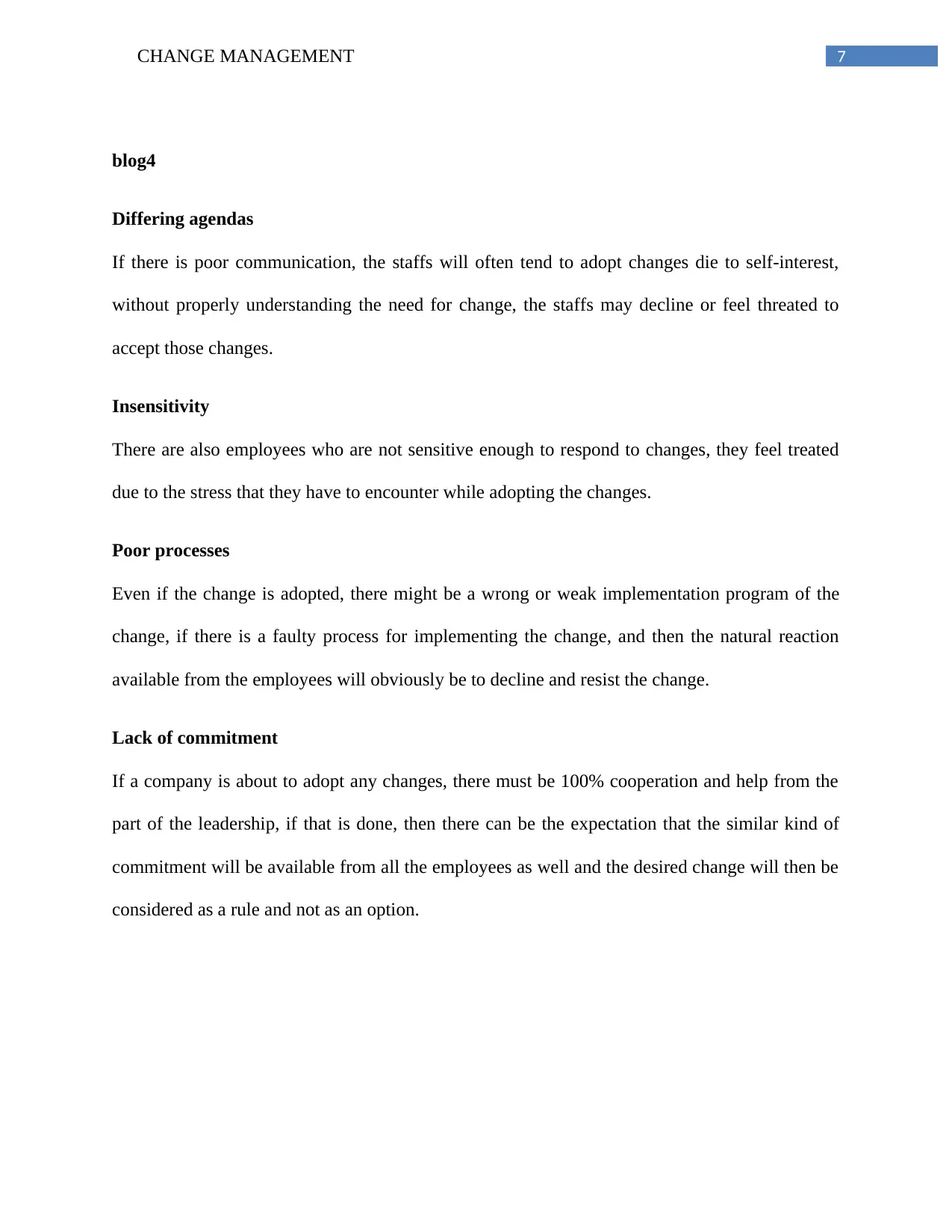
7CHANGE MANAGEMENT
blog4
Differing agendas
If there is poor communication, the staffs will often tend to adopt changes die to self-interest,
without properly understanding the need for change, the staffs may decline or feel threated to
accept those changes.
Insensitivity
There are also employees who are not sensitive enough to respond to changes, they feel treated
due to the stress that they have to encounter while adopting the changes.
Poor processes
Even if the change is adopted, there might be a wrong or weak implementation program of the
change, if there is a faulty process for implementing the change, and then the natural reaction
available from the employees will obviously be to decline and resist the change.
Lack of commitment
If a company is about to adopt any changes, there must be 100% cooperation and help from the
part of the leadership, if that is done, then there can be the expectation that the similar kind of
commitment will be available from all the employees as well and the desired change will then be
considered as a rule and not as an option.
blog4
Differing agendas
If there is poor communication, the staffs will often tend to adopt changes die to self-interest,
without properly understanding the need for change, the staffs may decline or feel threated to
accept those changes.
Insensitivity
There are also employees who are not sensitive enough to respond to changes, they feel treated
due to the stress that they have to encounter while adopting the changes.
Poor processes
Even if the change is adopted, there might be a wrong or weak implementation program of the
change, if there is a faulty process for implementing the change, and then the natural reaction
available from the employees will obviously be to decline and resist the change.
Lack of commitment
If a company is about to adopt any changes, there must be 100% cooperation and help from the
part of the leadership, if that is done, then there can be the expectation that the similar kind of
commitment will be available from all the employees as well and the desired change will then be
considered as a rule and not as an option.
Paraphrase This Document
Need a fresh take? Get an instant paraphrase of this document with our AI Paraphraser
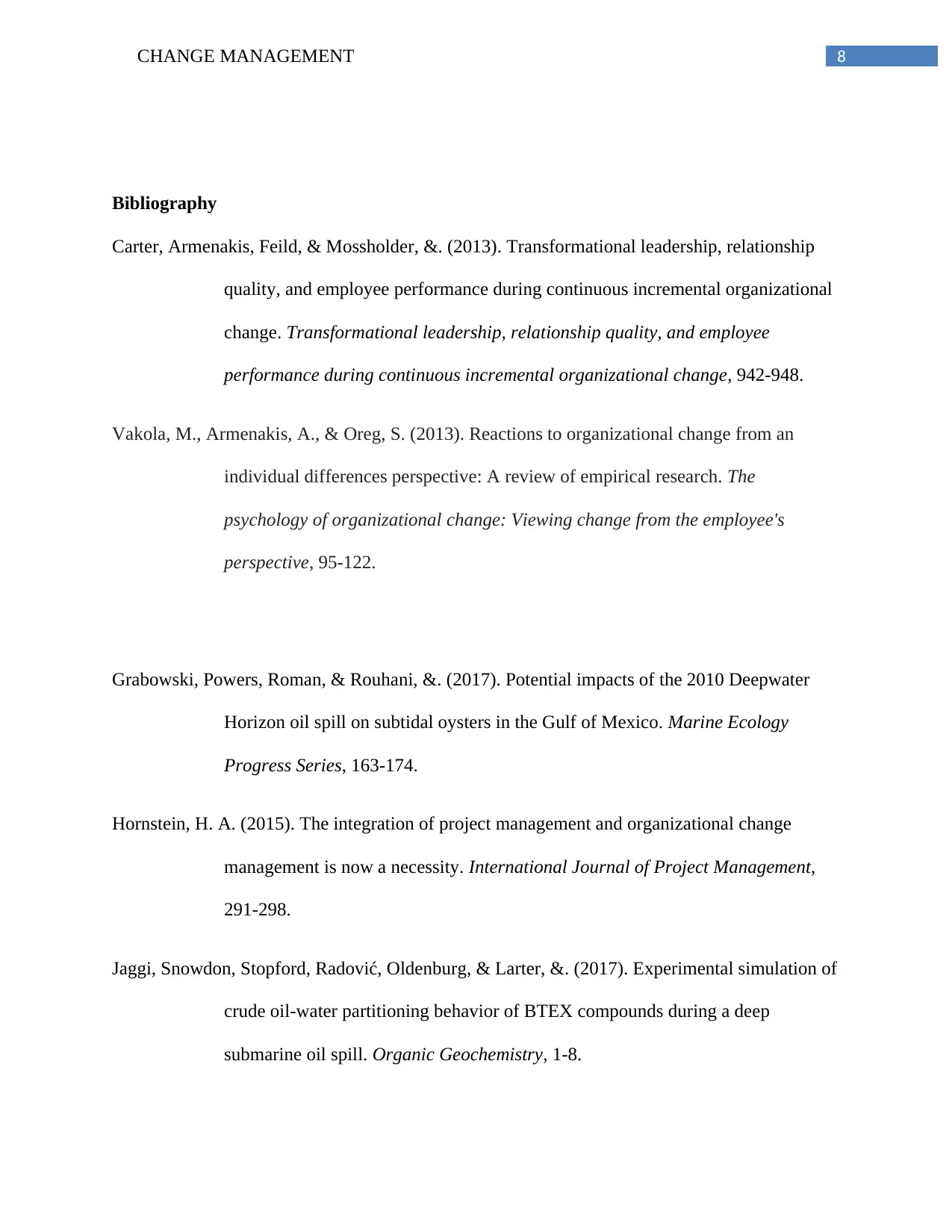
8CHANGE MANAGEMENT
Bibliography
Carter, Armenakis, Feild, & Mossholder, &. (2013). Transformational leadership, relationship
quality, and employee performance during continuous incremental organizational
change. Transformational leadership, relationship quality, and employee
performance during continuous incremental organizational change, 942-948.
Vakola, M., Armenakis, A., & Oreg, S. (2013). Reactions to organizational change from an
individual differences perspective: A review of empirical research. The
psychology of organizational change: Viewing change from the employee's
perspective, 95-122.
Grabowski, Powers, Roman, & Rouhani, &. (2017). Potential impacts of the 2010 Deepwater
Horizon oil spill on subtidal oysters in the Gulf of Mexico. Marine Ecology
Progress Series, 163-174.
Hornstein, H. A. (2015). The integration of project management and organizational change
management is now a necessity. International Journal of Project Management,
291-298.
Jaggi, Snowdon, Stopford, Radović, Oldenburg, & Larter, &. (2017). Experimental simulation of
crude oil-water partitioning behavior of BTEX compounds during a deep
submarine oil spill. Organic Geochemistry, 1-8.
Bibliography
Carter, Armenakis, Feild, & Mossholder, &. (2013). Transformational leadership, relationship
quality, and employee performance during continuous incremental organizational
change. Transformational leadership, relationship quality, and employee
performance during continuous incremental organizational change, 942-948.
Vakola, M., Armenakis, A., & Oreg, S. (2013). Reactions to organizational change from an
individual differences perspective: A review of empirical research. The
psychology of organizational change: Viewing change from the employee's
perspective, 95-122.
Grabowski, Powers, Roman, & Rouhani, &. (2017). Potential impacts of the 2010 Deepwater
Horizon oil spill on subtidal oysters in the Gulf of Mexico. Marine Ecology
Progress Series, 163-174.
Hornstein, H. A. (2015). The integration of project management and organizational change
management is now a necessity. International Journal of Project Management,
291-298.
Jaggi, Snowdon, Stopford, Radović, Oldenburg, & Larter, &. (2017). Experimental simulation of
crude oil-water partitioning behavior of BTEX compounds during a deep
submarine oil spill. Organic Geochemistry, 1-8.
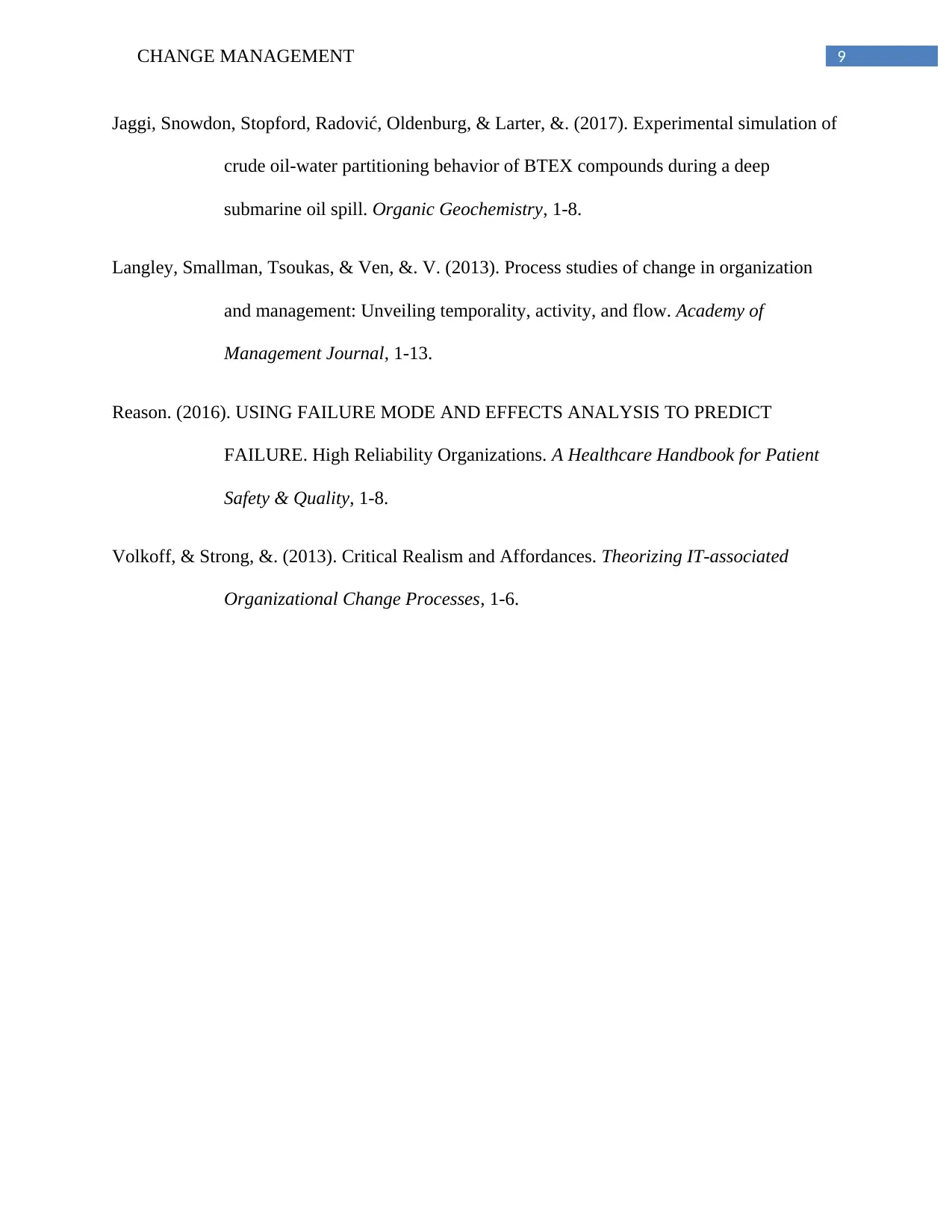
9CHANGE MANAGEMENT
Jaggi, Snowdon, Stopford, Radović, Oldenburg, & Larter, &. (2017). Experimental simulation of
crude oil-water partitioning behavior of BTEX compounds during a deep
submarine oil spill. Organic Geochemistry, 1-8.
Langley, Smallman, Tsoukas, & Ven, &. V. (2013). Process studies of change in organization
and management: Unveiling temporality, activity, and flow. Academy of
Management Journal, 1-13.
Reason. (2016). USING FAILURE MODE AND EFFECTS ANALYSIS TO PREDICT
FAILURE. High Reliability Organizations. A Healthcare Handbook for Patient
Safety & Quality, 1-8.
Volkoff, & Strong, &. (2013). Critical Realism and Affordances. Theorizing IT-associated
Organizational Change Processes, 1-6.
Jaggi, Snowdon, Stopford, Radović, Oldenburg, & Larter, &. (2017). Experimental simulation of
crude oil-water partitioning behavior of BTEX compounds during a deep
submarine oil spill. Organic Geochemistry, 1-8.
Langley, Smallman, Tsoukas, & Ven, &. V. (2013). Process studies of change in organization
and management: Unveiling temporality, activity, and flow. Academy of
Management Journal, 1-13.
Reason. (2016). USING FAILURE MODE AND EFFECTS ANALYSIS TO PREDICT
FAILURE. High Reliability Organizations. A Healthcare Handbook for Patient
Safety & Quality, 1-8.
Volkoff, & Strong, &. (2013). Critical Realism and Affordances. Theorizing IT-associated
Organizational Change Processes, 1-6.
⊘ This is a preview!⊘
Do you want full access?
Subscribe today to unlock all pages.

Trusted by 1+ million students worldwide
1 out of 9
Related Documents
Your All-in-One AI-Powered Toolkit for Academic Success.
+13062052269
info@desklib.com
Available 24*7 on WhatsApp / Email
![[object Object]](/_next/static/media/star-bottom.7253800d.svg)
Unlock your academic potential
Copyright © 2020–2025 A2Z Services. All Rights Reserved. Developed and managed by ZUCOL.




